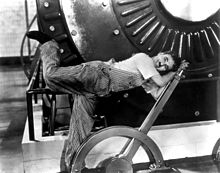Physical comedy

Physical comedy is a form of comedy focused on manipulation of the body for a humorous effect. It can include slapstick, clowning, mime, physical stunts, or making funny faces.[1]
Physical comedy originated as part of the Commedia dell'arte.[2] It is now sometimes incorporated into sitcoms; for example, in the sitcom Three's Company, actor John Ritter frequently performed pratfalls (landing on the buttocks). Cartoons, particularly film shorts, also commonly depict an exaggerated form of physical comedy (incorporating cartoon physics), such as in Tom and Jerry and Wile E. Coyote and the Road Runner.[3]
Slapstick elements include the trip, the slip, the double take, the collide, the fall (or faint), and the roar.[clarification needed]
Examples[]
Charlie Chaplin started his film career as a physical comedian; although he developed additional means of comic expression, Chaplin's mature works continued to contain elements of slapstick.
Other comedians to employ physical comedy as a medium for their characters include Buster Keaton, The Three Stooges, Laurel and Hardy, Benny Hill, Lucille Ball, Harpo Marx, Martin Short, Chevy Chase, Don Knotts, Jerry Lewis, Danny Kaye, and Johnny Lever.
In sitcoms, the use of physical comedy was seen in, for example,
- Dick van Dyke's character Rob Petrie on The Dick Van Dyke Show,
- Larry Hagman's character Major Anthony Nelson on I Dream of Jeannie,
- John Ritter's character Jack Tripper on Three's Company,
- The two main characters of Mark Linn-Baker and Bronson Pinchot on Perfect Strangers,
- Michael Richards's character Cosmo Kramer on Seinfeld,
- Penny Marshall's character Laverne DeFazio and Cindy Williams' character Shirley Feeney on Laverne & Shirley,
- Jennifer Saunders' character Edina Monsoon and Joanna Lumley's character Patsy Stone on Absolutely Fabulous,
- Neil Morrissey's character Tony in Men Behaving Badly,
- Jennifer Aniston's character Rachel Green in Friends,
- Rowan Atkinson's character Mr. Bean,
- Jaleel White's character Steve Urkel on Family Matters
- Rik Mayall's and Adrian Edmondson's characters Richard Richard and Eddie Hitler in Bottom.
In the movies, physical comedy is used by, for example,
- Peter Sellers as Chief Inspector Clouseau in The Pink Panther film series.
- Zero Mostel's character Max Bialystock in The Producers
- Bette Midler's, Goldie Hawn's and Diane Keaton's characters in The First Wives Club
- Will Ferrell's and John C. Reilly's characters in Step Brothers
- Zac Efron's and Adam DeVine's characters in Mike and Dave Need Wedding Dates
See also[]
References[]
- ^ "Get Funny! Tips on Directing Physical Comedy". Videomaker.com. Retrieved 2015-11-29.
- ^ "History of Physical Comedy - Roundabout Theatre Company Official Blog". blog.roundabouttheatre.org. Retrieved 2015-11-29.
- ^ "What is Physical Comedy? (with pictures)". wiseGEEK. Retrieved 2015-11-29.
- Comedy genres
- Slapstick comedy
- Comedy stubs